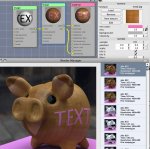"See Through" PNG to Underlying Material?
I've searched and found references to transparent PNG's and decals, but I haven't found any clear-cut description for how to apply a transparent PNG image as a texture and be able to "see through" the transparent portions to the underlying material. Whenever I try, the surface becomes transparent - i.e. you can see through the object.
For instance, I want to curl a page of text. The text is a 24-bit PNG so that everything but the text is transparent. How do I apply that to my object so that the underlying surface is visible behind the text?
Thanks for any help,
-Steve
I've searched and found references to transparent PNG's and decals, but I haven't found any clear-cut description for how to apply a transparent PNG image as a texture and be able to "see through" the transparent portions to the underlying material. Whenever I try, the surface becomes transparent - i.e. you can see through the object.
For instance, I want to curl a page of text. The text is a 24-bit PNG so that everything but the text is transparent. How do I apply that to my object so that the underlying surface is visible behind the text?
Thanks for any help,
-Steve














